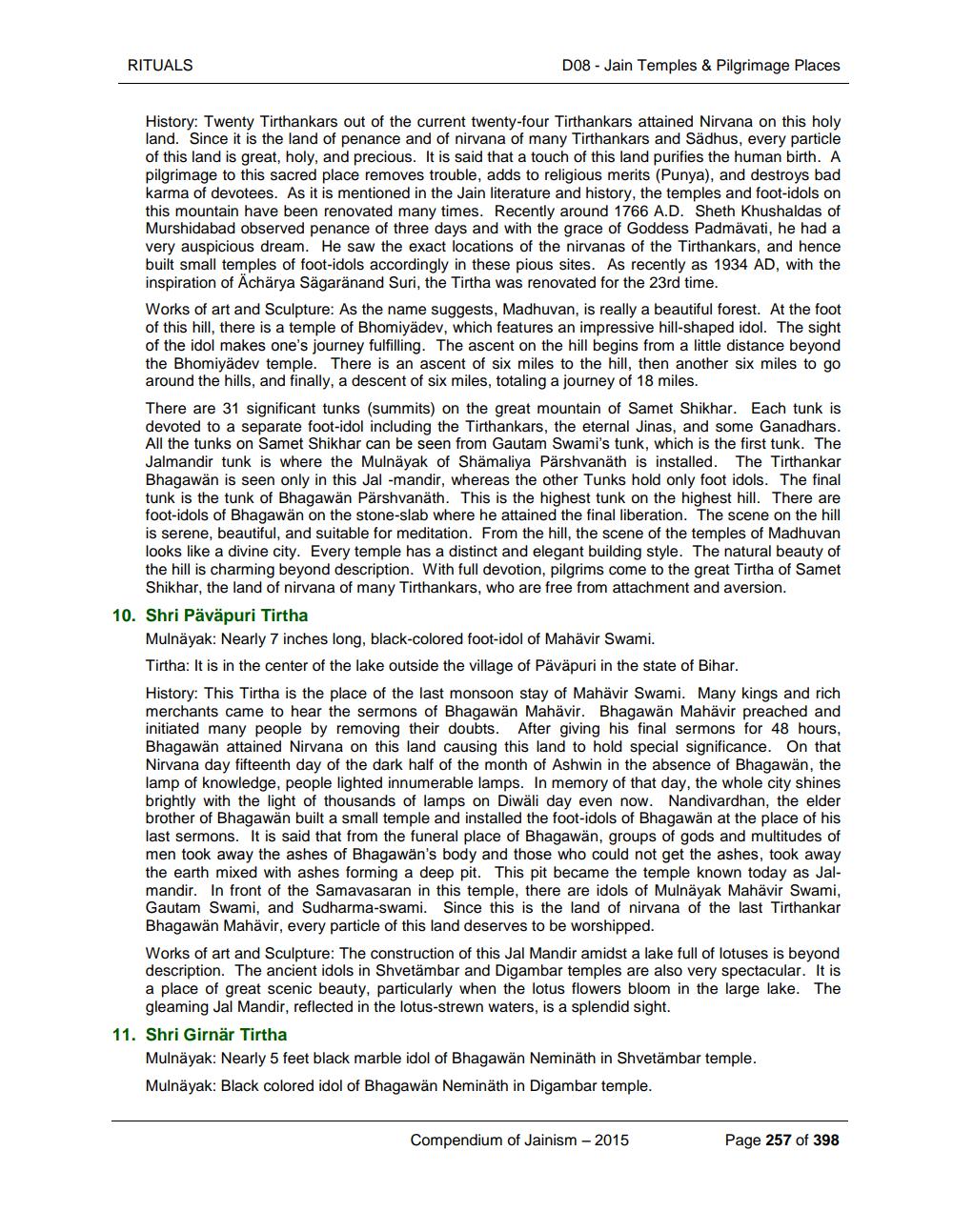________________
RITUALS
D08 - Jain Temples & Pilgrimage Places
History: Twenty Tirthankars out of the current twenty-four Tirthankars attained Nirvana on this holy land. Since it is the land of penance and of nirvana of many Tirthankars and Sädhus, every particle of this land is great, holy, and precious. It is said that a touch of this land purifies the human birth. A pilgrimage to this sacred place removes trouble, adds to religious merits (Punya), and destroys bad karma of devotees. As it is mentioned in the Jain literature and history, the temples and foot-idols on this mountain have been renovated many times. Recently around 1766 A.D. Sheth Khushaldas of Murshidabad observed penance of three days and with the grace of Goddess Padmavati, he had a very auspicious dream. He saw the exact locations of the nirvanas of the Tirthankars, and hence built small temples of foot-idols accordingly in these pious sites. As recently as 1934 AD, with the inspiration of Acharya Sägaränand Suri, the Tirtha was renovated for the 23rd time. Works of art and Sculpture: As the name suggests, Madhuvan, is really a beautiful forest. At the foot of this hill, there is a temple of Bhomiyädev, which features an impressive hill-shaped idol. The sight of the idol makes one's journey fulfilling. The ascent on the hill begins from a little distance beyond the Bhomiyädev temple. There is an ascent of six miles to the hill, then another six miles to go around the hills, and finally, a descent of six miles, totaling a journey of 18 miles. There are 31 significant tunks (summits) on the great mountain of Samet Shikhar. Each tunk is devoted to a separate foot-idol including the Tirthankars, the eternal Jinas, and some Ganadhars. All the tunks on Samet Shikhar can be seen from Gautam Swami's tunk, which is the first tunk. The Jalmandir tunk is where the Mulnayak of Shamaliya Pärshvanath is installed. The Tirthankar Bhagawan is seen only in this Jal -mandir, whereas the other Tunks hold only foot idols. The final tunk is the tunk of Bhagawan Pärshvanath. This is the highest tunk on the highest hill. There are foot-idols of Bhagawan on the stone-slab where he attained the final liberation. The scene on the hill is serene, beautiful, and suitable for meditation. From the hill, the scene of the temples of Madhuvan looks like a divine city. Every temple has a distinct and elegant building style. The natural beauty of the hill is charming beyond description. With full devotion, pilgrims come to the great Tirtha of Samet
Shikhar, the land of nirvana of many Tirthankars, who are free from attachment and aversion. 10. Shri Päväpuri Tirtha
Mulnäyak: Nearly 7 inches long, black-colored foot-idol of Mahävir Swami. Tirtha: It is in the center of the lake outside the village of Päväpuri in the state of Bihar. History: This Tirtha is the place of the last monsoon stay of Mahävir Swami. Many kings and rich merchants came to hear the sermons of Bhagawan Mahävir. Bhagawan Mahävir preached and initiated many people by removing their doubts. After giving his final sermons for 48 hours, Bhagawan attained Nirvana on this land causing this land to hold special significance. On that Nirvana day fifteenth day of the dark half of the month of Ashwin in the absence of Bhagawan, the lamp of knowledge, people lighted innumerable lamps. In memory of that day, the whole city shines brightly with the light of thousands of lamps on Diwali day even now. Nandivardhan, the elder brother of Bhagawan built a small temple and installed the foot-idols of Bhagawan at the place of his last sermons. It is said that from the funeral place of Bhagawan, groups of gods and multitudes of men took away the ashes of Bhagawan's body and those who could not get the ashes, took away the earth mixed with ashes forming a deep pit. This pit became the temple known today as Jalmandir. In front of the Samavasaran in this temple, there are idols of Mulnayak Mahävir Swami, Gautam Swami, and Sudharma-swami. Since this is the land of nirvana of the last Tirthankar Bhagawan Mahävir, every particle of this land deserves to be worshipped. Works of art and Sculpture: The construction of this Jal Mandir amidst a lake full of lotuses is beyond description. The ancient idols in Shvetämbar and Digambar temples are also very spectacular. It is a place of great scenic beauty, particularly when the lotus flowers bloom in the large lake. The
gleaming Jal Mandir, reflected in the lotus-strewn waters, is a splendid sight. 11. Shri Girnär Tirtha
Mulnäyak: Nearly 5 feet black marble idol of Bhagawan Neminäth in Shvetämbar temple. Mulnäyak: Black colored idol of Bhagawan Neminäth in Digambar temple.
Compendium of Jainism - 2015
Page 257 of 398




